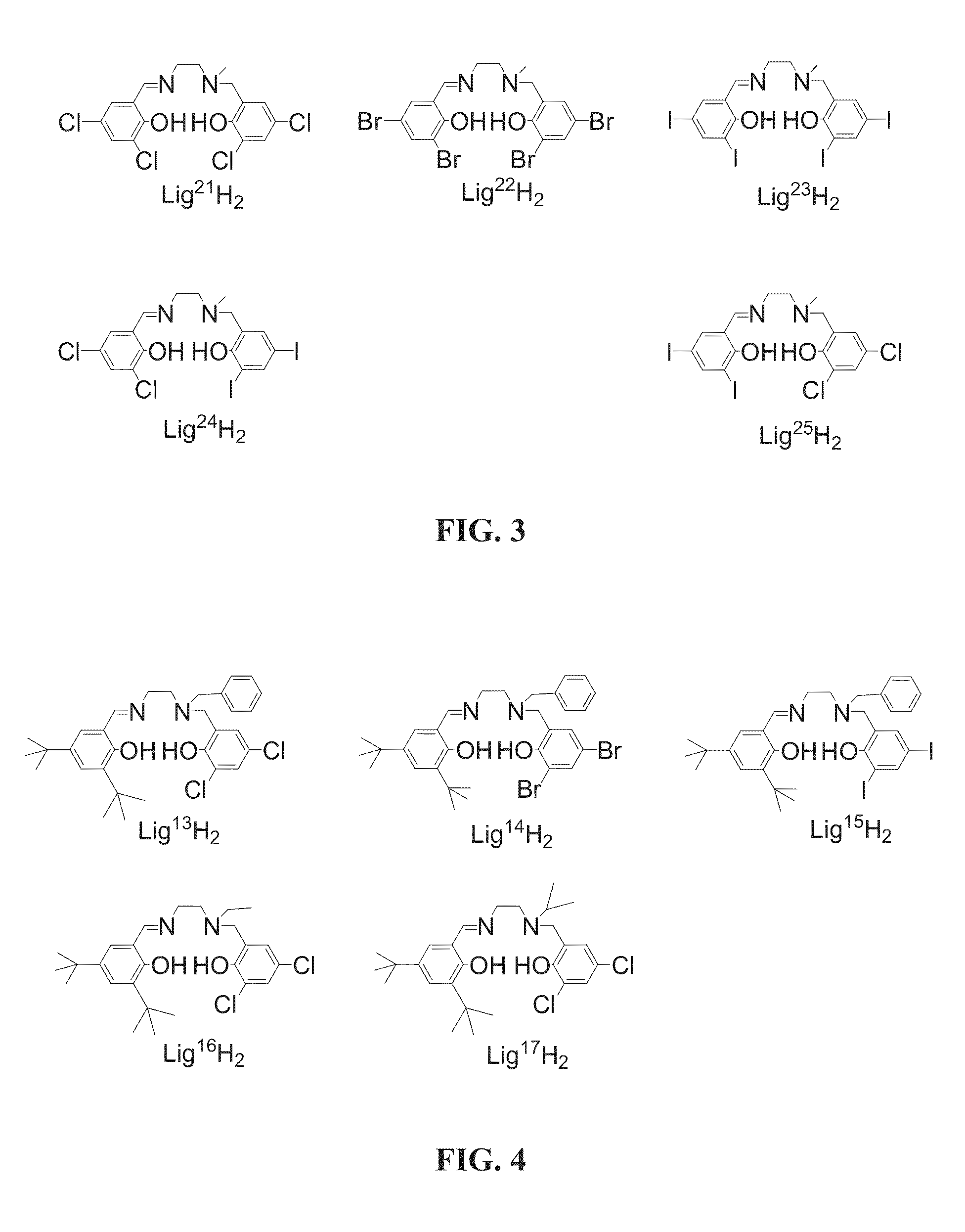Salalen ligands and organometallic complexes
a technology of organometallic complexes and ligands, which is applied in the field of chemistry, can solve the problems of the inability to meet the requirements of the ligands, so as to achieve the effect of substantial effect on the efficiency of the polymerization process and on the properties
- Summary
- Abstract
- Description
- Claims
- Application Information
AI Technical Summary
Benefits of technology
Problems solved by technology
Method used
Image
Examples
example 1
Salalen Ligand Precursors
[0445]A variety of Salalen ligand precursors were prepared. The ligand precursors were designed to include a broad variety of structural modifications that lead to controlled variation of the structures of catalyst systems containing same, and thereby may control the catalytic activity of these catalyst systems, for example, by means of controlling the properties of polymers produced by catalytic polymerization.
[0446]The prepared Salalen ligand precursors include the following structural variations: variations of the diamine backbone forming the bridging moiety, including, for example, different lengths, rigidities and chemical character; and different substituents of the tertiary amine donor, including, for example, alkyl groups of different bulk and nature such as methyl, ethyl, isopropyl or benzyl; and variation of the substitution patterns on the two phenol rings, by means of, for example, alkyl, cycloalkyl or aryl substituents of different bulk, and hal...
example 2
Synthesis of Metal Complexes
[0666]Group IV metal complexes of various Salalen ligands were synthesized by reacting the ligand precursors with the appropriate metal (titanium, zirconium, or hafnium) reagent (referred to herein also as a metallic reagent) in an equimolar ratio as generally depicted in Scheme 6 below.
[0667]
[0668]wherein R1-R8 and R are as defined herein; B is a bridge between the two nitrogens, and can be, for example, ethylene, propylene, 2-aminomethylaniline, or can form with R a heterocyclic ring such as aminomethylpyrollidone; M is Hf, Zr or Ti; and X is a labile group, as defined herein, including, for example, Cl, O-iPr, O-tBu, benzyl (Bn), HNMe2, etc.; and “p” is an integer, preferably being 1 or 2.
[0669]The formed complex depicted in Scheme 6 can include additional neutral ligands which are not presented in the structure.
[0670]Exemplary metallic reagents that were used for obtaining the metal complexes include, without limitation, TiBn4, Ti(O-iPr)4, TiCl4, Ti(N...
example 3
Catalytic Polymerization
[0719]The metal complexes described herein were employed in polymerization of olefins. Several polymerization procedures were employed, depending on the pre-catalyst and the monomer of choice. Dibenzyl pre-catalysts are typically activated with either boron-type co-catalysts or with MAO. Other pre-catalysts, such as dichloro complexes, are typically activated with MAO.
[0720]In a typical polymerization procedure of a monomer which is liquid at atmospheric pressure like 1-hexene, the metal complex was added to this said monomer and the co-catalyst was added to a second portion of the same monomer. Mixing these two portions led to initiation of the polymerization process which was continued for a period of time that depended on the rate of the polymerization process and ranged from below 1 minute to several hours. The excess of the remaining monomer was removed under reduced pressure, traces of the non-polymeric materials (resulting from the catalyst and co-cata...
PUM
| Property | Measurement | Unit |
|---|---|---|
| melting point | aaaaa | aaaaa |
| Tm | aaaaa | aaaaa |
| melting transition temperature | aaaaa | aaaaa |
Abstract
Description
Claims
Application Information
 Login to View More
Login to View More - R&D
- Intellectual Property
- Life Sciences
- Materials
- Tech Scout
- Unparalleled Data Quality
- Higher Quality Content
- 60% Fewer Hallucinations
Browse by: Latest US Patents, China's latest patents, Technical Efficacy Thesaurus, Application Domain, Technology Topic, Popular Technical Reports.
© 2025 PatSnap. All rights reserved.Legal|Privacy policy|Modern Slavery Act Transparency Statement|Sitemap|About US| Contact US: help@patsnap.com



